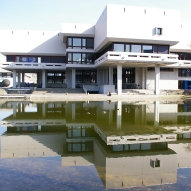Zusammenfassung
The reaction of (tht)AuCl (tht = tetrahydrothiophene) with the bulky phosphine ligand Ad₂BnP yields [(Ad₂BnP)₂Au][AuCl₂] (1, Ad = 1-adamantyl, Bn = benzyl) as the first example of a 1:1 chloro(phosphine)gold(I) complex having an ionic structure both in solution and solid state. The crystal structure of 1 revealed that the Au(I) atom is linearly coordinated by the phosphorus atoms and effectively ...
Zusammenfassung
The reaction of (tht)AuCl (tht = tetrahydrothiophene) with the bulky phosphine ligand Ad₂BnP yields [(Ad₂BnP)₂Au][AuCl₂] (1, Ad = 1-adamantyl, Bn = benzyl) as the first example of a 1:1 chloro(phosphine)gold(I) complex having an ionic structure both in solution and solid state. The crystal structure of 1 revealed that the Au(I) atom is linearly coordinated by the phosphorus atoms and effectively shielded from the surroundings by the bulky substituents of the phosphine ligand. For comparison, the analogous complex
(Ad₂nBuP)AuCl (2, nBu = n-butyl) has been synthesized and analysed by single crystal X-ray diffraction. In its crystal, it has a common rod-like structure known from R₃PAuCl complexes with bulky phosphine ligands.




 Altmetric
Altmetric